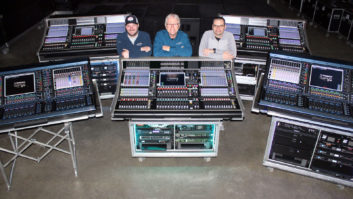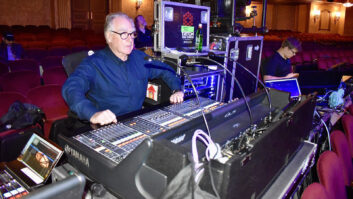The University of California, Irvine is home to a celebrated Sound Design program created in 2006. Under the umbrella of the Drama department at the university’s Claire Trevor School of the Arts, the program is spearheaded by Mike Hooker along with Vincent Olivieri, who is the head of the undergraduate sound design program. Late in 2012, the department added a DiGiCo SD9, DRack and UB MADI into its inventory, which made its debut on a series of student-designed programs this spring. One of those shows was the Festival of New Musicals, a unique partnership between the university and the Academy for New Musical Theater, a three-decade-old creative incubator. The alliance paired the talents of professional writers and composers affiliated with the ANMT with UCI students to create the fourth annual festival, staged at UCI’s xMPL – Experimental Media Performance Lab (featuring a flexible seating capacity of 25-150) this spring. One of the festival pieces, ‘Digital Natives’, featured sound design by second year MFA student, Matt Glenn. [Pictured L to R: UCI MFA student, Matt Glenn; Karli Blalock, Assistant Sound Designer; Vincent Olivieri, head of UCI’s undergraduate sound design program.]
“One of the interesting things about the way we run our sound design program here is that, with little exception, all of the equipment we own is independent of venue,” explains Olivieri. “Most of the equipment is kept in storage, in workshop rooms, and when a show is being developed, the sound designers are able to choose the tools that they need for their particular project, and can spec what they need and just plug in and play.”
The SD9 was the first DiGiCo purchased by the school and was chosen by Mike Hooker, UCI’s Head of Sound Design, in conjunction with RSPE Audio Solutions. “We knew that we were looking for a digital console of a certain size,” Olivieri recalls, “something that was beefy and designed for live playback and mid-range in size. The SD9 fitted that bill perfectly as it’s great for a mid-size show like this.”
The ‘Digital Natives’ piece comprised a juxtaposition of technology and digital feeds against a backdrop of singers and piano accompaniment for a total of 27 inputs (mics, iPod feeds, playback audio off of multiple computers) and a dozen outputs. Glenn configured a deceptively complex playback system, complete with different sounds and setups configured on different templates within the console. Having the ability to recall these different scenes at the push of a button was huge. Additionally, the SD9 was the perfect console not only for its expandability and versatility, but also for its diminutive size for the small theatre space. And, for a first-time user, Glenn was able to get up to speed quickly by watching the online product videos prior to getting hands-on with the console.
“I wanted to keep the console size down, but I also couldn’t sacrifice the number of channels,” adds Glenn. “Back in the planning stages of this show, before I really knew what it was going to be, I didn’t necessarily know how many mics I would have or how big the pit would be but I wanted to keep open my options with the stage box. With the DiGiCo console, I could have up to 32 inputs from stage from just one D-Rack with the expandability for the future of adding another and you wouldn’t necessarily get that with other consoles. I also wanted an interface that I could intuitively navigate around. The SD9 has a structure similar to Pro Tools and other digital audio workstations (DAWs) and when I started playing with the SD9—my first time using a DiGiCo in a real setting—the way it’s laid out just made sense to me. I didn’t want to be fighting my own brain in the middle of tech, especially with this show, where it’s a really fast turnaround of only three-days. That, the expandability and the ability to write snapshots so quickly and easily, it just all came together with the SD9.”
Onstage, I have six Meyer loud speakers that make up the main system and a subwoofer, plus an additional six loudspeakers placed around the stage for various effects. I’m also using two different internal stereo reverbs that are feeding some of the main speakers. I’m also sending my playback channels to various places around the space to kind of give a surround sound for some of the cues, and they also add a bit of warmth for some of the voices onstage. During pre-production, every time I want to change an EQ or I how much reverb is on a person, I was able to program a macro to update the current snapshot I was working in, and quickly get to it without having to think twice about it. Having eight macro buttons is one of the things I love about this board. Beyond that, there’s so much more to explore with this console but honestly, this show is so fast-paced, I don’t get much of a chance to!”
Moving forward, Oliveiri says the console will serve them in myriad ways, for different productions in varying venues. “We do a lot of shows in a lot of different spaces, and the SD9 is going to be an excellent tool for us for mid-sized musicals and musical events. It’s also going to be useful for us on workshop productions, where the technical needs aren’t always completely known in the early planning stages. For those kinds of productions, the flexibility of a console like the SD9 is essential in order to allow the sound team to quickly respond to unexpected needs.”






